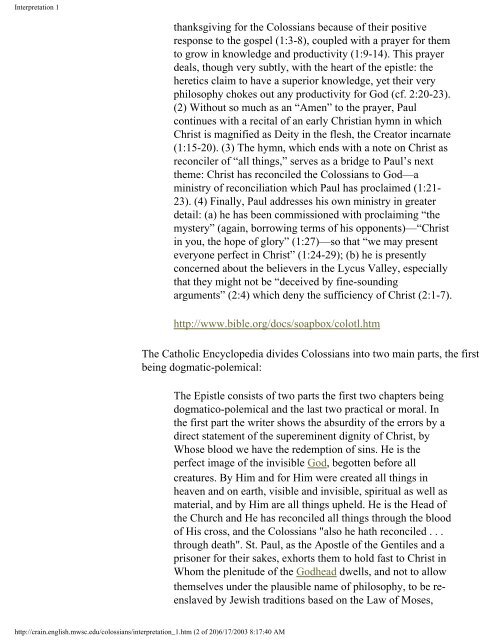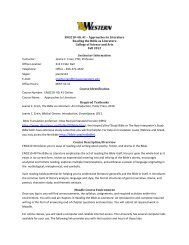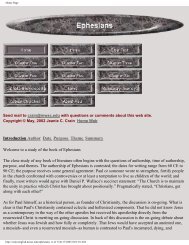Introduction to Colossians: Authorship, Date, Audience - Crain Home
Introduction to Colossians: Authorship, Date, Audience - Crain Home
Introduction to Colossians: Authorship, Date, Audience - Crain Home
You also want an ePaper? Increase the reach of your titles
YUMPU automatically turns print PDFs into web optimized ePapers that Google loves.
Interpretation 1<br />
thanksgiving for the <strong>Colossians</strong> because of their positive<br />
response <strong>to</strong> the gospel (1:3-8), coupled with a prayer for them<br />
<strong>to</strong> grow in knowledge and productivity (1:9-14). This prayer<br />
deals, though very subtly, with the heart of the epistle: the<br />
heretics claim <strong>to</strong> have a superior knowledge, yet their very<br />
philosophy chokes out any productivity for God (cf. 2:20-23).<br />
(2) Without so much as an “Amen” <strong>to</strong> the prayer, Paul<br />
continues with a recital of an early Christian hymn in which<br />
Christ is magnified as Deity in the flesh, the Crea<strong>to</strong>r incarnate<br />
(1:15-20). (3) The hymn, which ends with a note on Christ as<br />
reconciler of “all things,” serves as a bridge <strong>to</strong> Paul’s next<br />
theme: Christ has reconciled the <strong>Colossians</strong> <strong>to</strong> God—a<br />
ministry of reconciliation which Paul has proclaimed (1:21-<br />
23). (4) Finally, Paul addresses his own ministry in greater<br />
detail: (a) he has been commissioned with proclaiming “the<br />
mystery” (again, borrowing terms of his opponents)—“Christ<br />
in you, the hope of glory” (1:27)—so that “we may present<br />
everyone perfect in Christ” (1:24-29); (b) he is presently<br />
concerned about the believers in the Lycus Valley, especially<br />
that they might not be “deceived by fine-sounding<br />
arguments” (2:4) which deny the sufficiency of Christ (2:1-7).<br />
http://www.bible.org/docs/soapbox/colotl.htm<br />
The Catholic Encyclopedia divides <strong>Colossians</strong> in<strong>to</strong> two main parts, the first<br />
being dogmatic-polemical:<br />
http://crain.english.mwsc.edu/colossians/interpretation_1.htm (2 of 20)6/17/2003 8:17:40 AM<br />
The Epistle consists of two parts the first two chapters being<br />
dogmatico-polemical and the last two practical or moral. In<br />
the first part the writer shows the absurdity of the errors by a<br />
direct statement of the supereminent dignity of Christ, by<br />
Whose blood we have the redemption of sins. He is the<br />
perfect image of the invisible God, begotten before all<br />
creatures. By Him and for Him were created all things in<br />
heaven and on earth, visible and invisible, spiritual as well as<br />
material, and by Him are all things upheld. He is the Head of<br />
the Church and He has reconciled all things through the blood<br />
of His cross, and the <strong>Colossians</strong> "also he hath reconciled . . .<br />
through death". St. Paul, as the Apostle of the Gentiles and a<br />
prisoner for their sakes, exhorts them <strong>to</strong> hold fast <strong>to</strong> Christ in<br />
Whom the plenitude of the Godhead dwells, and not <strong>to</strong> allow<br />
themselves under the plausible name of philosophy, <strong>to</strong> be reenslaved<br />
by Jewish traditions based on the Law of Moses,






![[38cb1273][0][sourcelist][1][0] - Crain Home](https://img.yumpu.com/2168350/1/190x245/38cb12730sourcelist10-crain-home.jpg?quality=85)